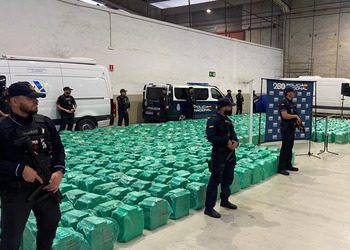The expansion of foreign criminal groups into Latin America has taken on a new dimension in the last decade, with European networks directly organizing drug shipments from the region.
Once dominated by Colombian organizations like the United Self Defense Forces of Colombia (Autodefensas Unidas de Colombia – AUC) and the Revolutionary Armed Forces of Colombia (Fuerzas Armadas Revolucionarias de Colombia – FARC), Colombia’s drug trafficking landscape changed radically after the FARC’s demobilization in 2016, and with it, Latin America’s cocaine pipeline to Europe.
Europe-based mafias are establishing their own routes and moving further down the cocaine pipeline. Italian mafia groups, especially in Colombia and Brazil, have expanded their presence, using cities like Medellín, Colombia, as logistical hubs.
To understand the changing dynamics of European criminal networks and their involvement in Latin America, InSight Crime spoke with Dr. Letizia Paoli, professor of criminology at the University of Leuven and international expert on mafia organizations.
InSight Crime (IC): How has Italian Mafia presence in Latin America evolved over the years?
Letizia Paoli (LP): Italian Mafias, including the Camorra and ‘Ndrangheta, established roots in Latin America as early as the 1970s. Initially, figures sought refuge in the region, but this presence evolved into more active participation in drug trafficking over time. While the trend became more visible in recent years, the Italian Mafia’s ties to Latin America date back decades, with many brokers and low-level operatives working to organize drug shipments rather than representing family interests in any official capacity.
IC: How does the broker model shape the operations of foreign mafias in Latin America?
LP: Increased law enforcement pressure has led Italian Mafias to rely on independent brokers rather than high-ranking family members for their Latin American operations. These brokers—typically younger and less prominent—are able to arrange drug shipments and negotiate deals with Colombian and other Latin American groups without formal ties to the Mafia families, which minimizes risk. This decentralized approach allows them to act as flexible intermediaries who can engage with a variety of criminal organizations on a per-transaction basis, adapting to changing market opportunities and avoiding exclusive affiliations. Consequently, this broker model represents a shift towards a networked, less hierarchical structure that keeps Mafia influence in Latin America active while reducing the visibility and vulnerability of their core leadership.
SEE ALSO: Italy’s Camorra Moves Into Colombia’s Cocaine Capital
IC: Do European criminal organizations have unique advantages in Colombia’s drug trade?
LP: The Italian Mafia, along with other European groups like Albanians, benefit from long-standing relationships with Colombian organizations, including the Gaitanist Self-Defense Forces of Colombia (Autodefensas Gaitanistas de Colombia – AGC). These partnerships provide direct access to cocaine suppliers and allow them to avoid local middlemen, maximizing profit. Collaborations are often temporary and pragmatic, with European crime syndicates joining forces with local groups on an as-needed basis for shipments.
IC: Why do Italian Mafias collaborate with other European crime syndicates, such as Albanian groups?
LP: Italian Mafias often team up with Albanian crime syndicates and other European groups to pool resources and expand operational reach. These partnerships are informal and opportunistic, allowing groups to capitalize on each other’s logistics and local contacts, reflecting a move toward flexible, collaborative crime networks rather than strict territorial control.
IC: How important is reputation for Mafia figures who relocate to Latin America?
LP: Reputation remains significant for Italian Mafia members abroad, as it allows them to use their established connections and the Mafia’s name to build trust with Latin American criminal partners. However, they focus less on projecting power over local populations and more on blending into the criminal underworld. Unlike Mafia figures in Southern Italy, these operatives operate without the cultural dominance typical in their homeland, adapting more as businessmen seeking reliable partnerships.
SEE ALSO: The Pioneering Albanian Trafficker Who Took Ecuador’s Drug Trade By Storm
IC: What makes Medellín and other Colombian cities suitable for Mafia activities?
LP: Medellín offers key logistical advantages for drug shipments, with established crime networks and strategic positioning for international trafficking. Although the city has implemented reforms, the local crime infrastructure and existing contacts allow Italian Mafias to coordinate shipments with local partners effectively. However, Medellín doesn’t necessarily offer distinct advantages over other Colombian cities, as Italian Mafia operatives can exploit multiple hubs depending on their needs.
IC: What other crimes, besides drug trafficking, are Italian Mafias connected to in Latin America?
LP: While their primary focus in Latin America is the cocaine trade, Italian Mafias also dabble in money laundering and, to a lesser extent, real estate. In Latin America and elsewhere outside their strongholds in Southern Italy, they have no ambition to exercise a political dominion and their primary goal is money-making.
IC: What role does police cooperation—or lack thereof—play in combating Mafia operations in Latin America?
LP: Police cooperation has improved significantly, especially within the European Union, but limitations remain in cross-border efforts with Latin American countries. Jurisdictional differences, resource constraints, and political barriers affect full cooperation, allowing Mafias to evade consistent surveillance. The balloon effect also complicates drug trade suppression. For example, in front of stricter controls in one port, criminal networks may simply shift the trade to another, maintaining overall cocaine availability in Europe.
*This interview was edited for clarity and fluency.
Featured Image: Spanish authorities seize 13 tons of cocaine in Algeciras on November 6. Credit: National Police of Spain.
Source link : http://www.bing.com/news/apiclick.aspx?ref=FexRss&aid=&tid=673f274830a64648864ab3f41e06bdb0&url=https%3A%2F%2Finsightcrime.org%2Fnews%2Fthe-rise-global-crime-networks-european-mafias-americas%2F&c=11375078292553998651&mkt=en-us
Author :
Publish date : 2024-11-18 02:54:00
Copyright for syndicated content belongs to the linked Source.
